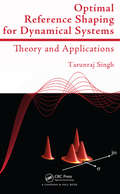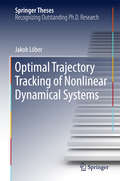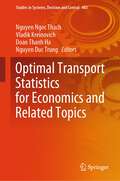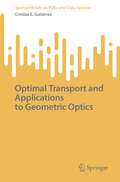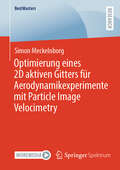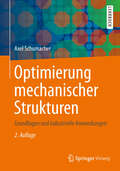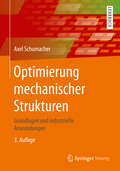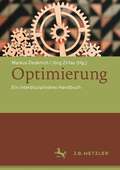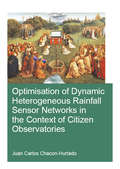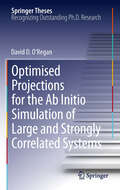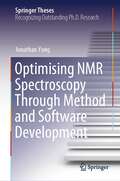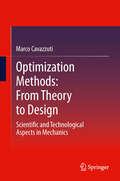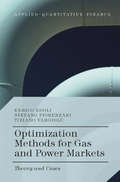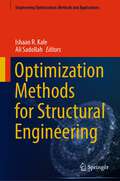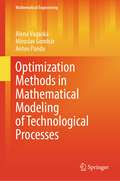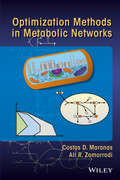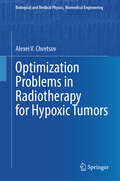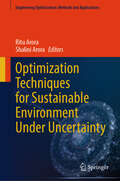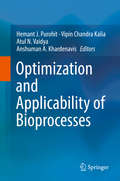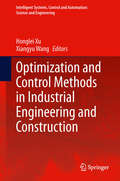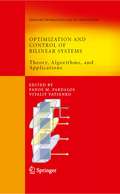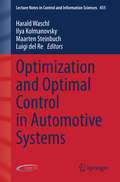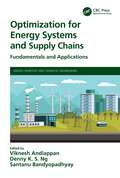- Table View
- List View
Optimal Reference Shaping for Dynamical Systems: Theory and Applications
by Tarunraj SinghIntegrating feedforward control with feedback control can significantly improve the performance of control systems compared to using feedback control alone. Focusing on feedforward control techniques, Optimal Reference Shaping for Dynamical Systems: Theory and Applications lucidly covers the various algorithms for attenuating residual oscillations
Optimal Trajectory Tracking of Nonlinear Dynamical Systems
by Jakob LöberBy establishing an alternative foundation of control theory, this thesis represents a significant advance in the theory of control systems, of interest to a broad range of scientists and engineers. While common control strategies for dynamical systems center on the system state as the object to be controlled, the approach developed here focuses on the state trajectory. The concept of precisely realizable trajectories identifies those trajectories that can be accurately achieved by applying appropriate control signals. The resulting simple expressions for the control signal lend themselves to immediate application in science and technology. The approach permits the generalization of many well-known results from the control theory of linear systems, e. g. the Kalman rank condition to nonlinear systems. The relationship between controllability, optimal control and trajectory tracking are clarified. Furthermore, the existence of linear structures underlying nonlinear optimal control is revealed, enabling the derivation of exact analytical solutions to an entire class of nonlinear optimal trajectory tracking problems. The clear and self-contained presentation focuses on a general and mathematically rigorous analysis of controlled dynamical systems. The concepts developed are visualized with the help of particular dynamical systems motivated by physics and chemistry.
Optimal Transport Statistics for Economics and Related Topics (Studies in Systems, Decision and Control #483)
by Vladik Kreinovich Nguyen Ngoc Thach Nguyen Duc Trung Doan Thanh HaThis volume emphasizes techniques of optimal transport statistics, but it also describes and uses other econometric techniques, ranging from more traditional statistical techniques to more innovative ones such as quantiles (in particular, multidimensional quantiles), maximum entropy approach, and machine learning. Applications range from general analysis of GDP growth, stock market, and consumer prices to analysis of specific sectors of economics (construction, credit and banking, energy, health, labor, textile, tourism, international trade) to specific issues affecting economy such as bankruptcy, effect of Covid-19 pandemic, effect of pollution, effect of gender, cryptocurrencies, and the existence of shadow economy. Papers presented in this volume also cover data processing techniques, with economic and financial application being the unifying theme. This volume shows what has been achieved, but even more important are remaining open problems. We hope that this volume will: inspire practitioners to learn how to apply state-of-the-art techniques, especially techniques of optimal transport statistics, to economic and financial problems, and inspire researchers to further improve the existing techniques and to come up with new techniques for studying economic and financial phenomena.
Optimal Transport and Applications to Geometric Optics (SpringerBriefs on PDEs and Data Science)
by Cristian E. GutiérrezThis book concerns the theory of optimal transport (OT) and its applications to solving problems in geometric optics. It is a self-contained presentation including a detailed analysis of the Monge problem, the Monge-Kantorovich problem, the transshipment problem, and the network flow problem. A chapter on Monge-Ampère measures is included containing also exercises. A detailed analysis of the Wasserstein metric is also carried out. For the applications to optics, the book describes the necessary background concerning light refraction, solving both far-field and near-field refraction problems, and indicates lines of current research in this area. Researchers in the fields of mathematical analysis, optimal transport, partial differential equations (PDEs), optimization, and optics will find this book valuable. It is also suitable for graduate students studying mathematics, physics, and engineering. The prerequisites for this book include a solid understanding of measure theory and integration, as well as basic knowledge of functional analysis.
Optimal Wellbeing of Ageing Wild Animals in Human Care
by Sarah Chapman Sabrina BrandoMany wild animals in human care live longer than their wild counterparts because of modern care and wellbeing programmes, leading to a growing demographic of ageing animals. This handbook is dedicated to their care. As an innovative expert publication, it integrates all aspects of professional care, including topics such as behaviour, ethics, environmental enrichment, training, veterinary care, nutrition and habitat design. Each animal is unique in their preferences, physical and emotional needs. Ageing animals may change their behaviour, alter the use space, and may also experience events and their relationships with their carers differently than they used to. The ageing process and death of an individual can be a significant event for others in their group, as well as the human carers.This book consolidates best practices for supporting and assessing optimal ageing animal wellbeing. It describes practical and science-informed approaches and philosophies regarding the care of ageing wild animals in zoos, aquariums, sanctuaries, universities and laboratories in a single source. This is an invaluable reference for veterinarians, animal care professionals, animal welfare researchers and students, and anyone with an interest in caring for animals.Personal stories and beautiful images of ageing individuals brightening the start of each chapter and remind us that what we do must be in the best interest of the animal and be at the heart of their care.
Optimierung eines 2D aktiven Gitters für Aerodynamikexperimente mit Particle Image Velocimetry (BestMasters)
by Simon MeckelnborgDie Ursprünge von aerodynamischen Lasten an den Rotorblättern einer Anlage sind vielfältig und komplex und können zu Betriebsschwierigkeiten und Beschädigungen von Komponenten einer Anlage führen. Ein hierbei herausstechender Effekt ist der dynamische Strömungsabriss am Rotorblatt, welcher durch unbeständige Einströmbedingungen an eben diesen erzeugt wird. Durch einen Strömungsabriss dieser Art kommt es zu variierenden Kräften am Rotorblatt, welche die zu erwartenden Lasten deutlich übersteigen. Es ist also von großem Interesse, die Vorgänge an einem Flügelprofil bei auftretendem dynamischen Strömungsabriss zu verstehen. In diesem Buch wird gezeigt, wie ein 2D aktives Gitter optimiert wird, um dieses 2D aktive Gitter in einem Versuchsaufbau für dynamische Strömungsabrissexperiemente zu werden. Darauf aufbauend wurden Aerodynamikexperimente an einem NACA0006 Flügelprofil mit Kraft- und Particle Image Velocimetry Messungen durchgeführt, welche den Zusammenhang zwischen der Aerodynamik am Flügelprofil und den am Flügelprofil wirkenden Kräften aufzeigen.
Optimierung mechanischer Strukturen
by Axel SchumacherZiel des Buches ist es, die notwendigen Kenntnisse für den effizienten Einsatz von mathematischen Optimierungsverfahren in der Strukturauslegung von Bauteilen zu vermitteln. Der Autor bezieht die neuesten Entwicklungen und Anwendungsbereiche auf dem Gebiet der Optimierung ein.
Optimierung mechanischer Strukturen: Grundlagen und industrielle Anwendungen
by Axel SchumacherZiel des Buches ist es, die notwendigen Kenntnisse für den effizienten Einsatz von mathematischen Optimierungsverfahren in der Strukturauslegung von Bauteilen zu vermitteln. Der Autor bezieht die neuesten Entwicklungen und Anwendungsbereiche auf dem Gebiet der Optimierung ein.
Optimierung: Ein interdisziplinäres Handbuch
by Jörg Zirfas Markus DederichDieses interdisziplinäre Handbuch rekonstruiert Optimierung als ein Phänomen, das konstitutiv in aktuelle Entwicklungen der Gegenwart eingeschrieben ist. Denn es erscheint kaum mehr möglich, nicht optimieren zu wollen oder zu können. Das gilt für die Arbeit an sich selbst, die Verbesserung des Anderen und die Perfektionierung der Welt. Optimierung verspricht messbare Steigerungen von Effektivität und Effizienz sowie eine Erweiterung der Reichweite von Einfluss und Macht. Sie wirft aber auch Fragen der Instrumentalisierung, der Verdinglichung und Entfremdung sowie Fragen nach Grenzen und Unverbesserlichkeiten auf. Ohne eine Auseinandersetzung mit der Idee der Optimierung lässt sich eine moderne Humanwissenschaft heute nicht mehr konzipieren.
Optimisation of Dynamic Heterogeneous Rainfall Sensor Networks in the Context of Citizen Observatories (IHE Delft PhD Thesis Series)
by Juan Carlos Chacon-HurtadoPrecipitation drives the dynamics of flows and storages in water systems, making its monitoring essential for water management. Conventionally, precipitation is monitored using in-situ and remote sensors. In-situ sensors are arranged in networks, which are usually sparse, providing continuous observations for long periods at fixed points in space, and due to the high costs of such networks, they are often sub-optimal. To increase the efficiency of the monitoring networks, we explore the use of sensors that can relocate as rainfall events develop (dynamic sensors), as well as increasing the number of sensors involving volunteers (citizens). This research focusses on the development of an approach for merging heterogeneous observations in non-stationary precipitation fields, exploring the interactions between different definitions of optimality for the design of sensor networks, as well as development of algorithms for the optimal scheduling of dynamic sensors. This study was carried out in three different case studies, including Bacchiglione River (Italy), Don River (U.K.) and Brue Catchment (U.K.) The results of this study indicate that optimal use of dynamic sensors may be useful for monitoring precipitation to support water management and flow forecasting.
Optimised Projections for the Ab Initio Simulation of Large and Strongly Correlated Systems
by David D. O'ReganDensity functional theory (DFT) has become the standard workhorse for quantum mechanical simulations as it offers a good compromise between accuracy and computational cost. However, there are many important systems for which DFT performs very poorly, most notably strongly-correlated materials, resulting in a significant recent growth in interest in 'beyond DFT' methods. The widely used DFT+U technique, in particular, involves the addition of explicit Coulomb repulsion terms to reproduce the physics of spatially-localised electronic subspaces. The magnitude of these corrective terms, measured by the famous Hubbard U parameter, has received much attention but less so for the projections used to delineate these subspaces. The dependence on the choice of these projections is studied in detail here and a method to overcome this ambiguity in DFT+U, by self-consistently determining the projections, is introduced. The author shows how nonorthogonal representations for electronic states may be used to construct these projections and, furthermore, how DFT+U may be implemented with a linearly increasing cost with respect to system size. The use of nonorthogonal functions in the context of electronic structure calculations is extensively discussed and clarified, with new interpretations and results, and, on this topic, this work may serve as a reference for future workers in the field.
Optimising NMR Spectroscopy Through Method and Software Development (Springer Theses)
by Jonathan YongThis book provides a comprehensive overview of Nuclear Magnetic Resonance (NMR) theory, its applications, and advanced techniques to improve the quality and speed of NMR data acquisition. In this book, the author expands his outstanding Ph.D. thesis and provides a valuable resource for researchers, professionals, and students in the field of NMR spectroscopy. The book covers quantum mechanics basics, and topics like density operators, pulse sequences, 1D pulse acquisition, INEPT (Insensitive nuclei enhancement by polarization transfer), product operators, and 2D NMR principles. It also explores innovative experiments like States HSQC (Heteronuclear Single Quantum Coherence) and echo-antiecho HSQC with gradients. In the subsequent chapters, the author discusses Pure Shift NMR, including PSYCHE (Pure Shift Yielded by Chirp Excitation) and its optimizations, such as waveform parameterization and time-reversal methods. The 'Discrete PSYCHE' approach and Ultrafast PSYCHE-iDOSY (Diffusion-ordered spectroscopy) are also highlighted. This book presents the POISE (Parameter Optimisation by Iterative Spectral Evaluation) software for real-time NMR experiment optimization, including pulse width calibration and Ernst angle optimization, and demonstrates applications across various NMR experiments. Lastly, the book examines accelerated 2D NMR data collection and the NOAH (NMR by Ordered Acquisition using 1H detection) supersequences, emphasizing automated pulse program creation using GENESIS (GENEration of Supersequences In Silico). Covered NMR experiments include 13C sensitivity-enhanced HSQC, 15N HMQC (Heteronuclear Multiple Quantum Coherence), dual HSQC, HSQC-TOCSY (Total Correlation Spectroscopy), HMBC (Heteronuclear Multiple Bond Correlation), and ADEQUATE (Adequate Sensitivity Double-Quantum Spectroscopy).
Optimization Methods
by Marco CavazzutiThis book is about optimization techniques and is subdivided into two parts. In the first part a wide overview on optimization theory is presented. Optimization is presented as being composed of five topics, namely: design of experiment, response surface modeling, deterministic optimization, stochastic optimization, and robust engineering design. Each chapter, after presenting the main techniques for each part, draws application oriented conclusions including didactic examples. In the second part some applications are presented to guide the reader through the process of setting up a few optimization exercises, analyzing critically the choices which are made step by step, and showing how the different topics that constitute the optimization theory can be used jointly in an optimization process. The applications which are presented are mainly in the field of thermodynamics and fluid dynamics due to the author's background.
Optimization Methods for Gas and Power Markets: Theory and Cases (Applied Quantitative Finance)
by Stefano Fiorenzani Enrico Edoli Tiziano VargioluAs power and gas markets are becoming more and more mature and globally competitive, the importance of reaching maximum potential economic efficiency is fundamental in all the sectors of the value chain, from investments selection to asset optimization, trading and sales. Optimization techniques can be used in many different fields of the energy industry, in order to reduce production and financial costs, increase sales revenues and mitigate all kinds of risks potentially affecting the economic margin. For this reason the industry has now focused its attention on the general concept of optimization and to the different techniques (mainly mathematical techniques) to reach it.Optimization Methods for Gas and Power Markets presents both theoretical elements and practical examples for solving energy optimization issues in gas and power markets. Starting with the theoretical framework and the basic business and economics of power and gas optimization, it quickly moves on to review the mathematical optimization problems inherent to the industry, and their solutions – all supported with examples from the energy sector. Coverage ranges from very long-term (and capital intensive) optimization problems such as investment valuation/diversification to asset (gas and power) optimization/hedging problems, and pure trading decisions.This book first presents the readers with various examples of optimization problems arising in power and gas markets, then deals with general optimization problems and describes the mathematical tools useful for their solution. The remainder of the book is dedicated to presenting a number of key business cases which apply the proposed techniques to concrete market problems. Topics include static asset optimization, real option evaluation, dynamic optimization of structured products like swing, virtual storage or virtual power plant contracts and optimal trading in intra-day power markets. As the book progresses, so too does the level of mathematical complexity, providing readers with an appreciation of the growing sophistication of even common problems in current market practice.Optimization Methods for Gas and Power Markets provides a valuable quantitative guide to the technicalities of optimization methodologies in gas and power markets; it is essential reading for practitioners in the energy industry and financial sector who work in trading, quantitative analysis and energy risk modeling.
Optimization Methods for Structural Engineering (Engineering Optimization: Methods and Applications)
by Ishaan R. Kale Ali SadollahThis contributed book focuses on optimization methods inspired by nature such as Harmony Search Algorithm, Drosophila Food-Search Algorithm, Cohort intelligence algorithm and its variations, fuzzy logic along with their hybridization variants. It also focuses on multi-objective optimization algorithms such as Non-Dominated Sorting Genetic Algorithm, Particle Swarm Optimization, Evolutionary Algorithm, Pareto Envelope Selection Algorithm, and Strength Pareto Evolutionary Algorithm. The content focuses on topics such as the optimal design of truss systems with various applications, the design and simulation of quarter car systems for comfort design, the road handling design and a balanced system, and topology optimization of 2-dimensional and 3-dimensional structure in linear elasticity, plasticity and fracture mechanics among others. This book is a useful reference for those in academia and industry.
Optimization Methods in Mathematical Modeling of Technological Processes (Mathematical Engineering)
by Anton Panda Alena Vagaská Miroslav GombárThis book focuses on selected methods of applied mathematics that are aimed at mathematical optimization, with an emphasis on their application in engineering practice. It delves into the current mathematical modeling of processes and systems, with a specific focus on the optimization modeling of technological processes. The authors discuss suitable linear, convex, and nonlinear optimization methods for solving problems in engineering practice. Real-world examples and data are used to numerically illustrate the implementation of these methods, utilizing the popular MATLAB software system and its extension to convex optimization. The book covers a wide range of topics, including mathematical modeling, linear programming, convex programming, and nonlinear programming, all with an engineering optimization perspective. It serves as a comprehensive guide for engineers, researchers, and students interested in the practical application of optimization methods in engineering.
Optimization Methods in Metabolic Networks
by Ali R. Zomorrodi Costas D. MaranasProvides a tutorial on the computational tools that use mathematical optimization concepts and representations for the curation, analysis and redesign of metabolic networks Organizes, for the first time, the fundamentals of mathematical optimization in the context of metabolic network analysis Reviews the fundamentals of different classes of optimization problems including LP, MILP, MLP and MINLP Explains the most efficient ways of formulating a biological problem using mathematical optimization Reviews a variety of relevant problems in metabolic network curation, analysis and redesign with an emphasis on details of optimization formulations Provides a detailed treatment of bilevel optimization techniques for computational strain design and other relevant problems
Optimization Problems in Radiotherapy for Hypoxic Tumors (Biological and Medical Physics, Biomedical Engineering)
by Alexei V. ChvetsovThis book highlights the mathematical aspects of treatment outcomes analysis and dose optimization in radiotherapy for heterogeneous hypoxic tumors. Hypoxia is a major factor of cancer resistance to radiotherapy treatment and is present in most tumors encountered in humans. The author tried to present a systematic consideration of radiotherapy for hypoxic tumors, but the emphasis was put on mathematical content of the problems. The book contains new approaches to the concepts of tumor control probability, equivalent uniform dose and radiotherapy dose optimization for hypoxic tumors developed by the author. Significant attention in this book is paid to comparison of models with measured and clinical data; therefore, the reduction of model parameters to overcome overfitting (model parsimony) was followed as much as possible.
Optimization Techniques for Sustainable Environment Under Uncertainty (Engineering Optimization: Methods and Applications)
by Ritu Arora Shalini AroraThe book's objective is to develop mathematical structures that can be applied to real-life problems with sustainable goals. It focuses on the impact of sustainable living on social, economic, and environmental aspects, aiming to create optimization techniques that minimize emissions and maximize green energy. These optimization problems may include sustainable transport, cities, economic development, living, and tourism. The book brings together researchers, academics, and professionals from various fields to find optimal or satisfactory solutions for various environmentally friendly sustainable problems. It aims to achieve this not only with existing optimization techniques, but also with novel approaches such as lexicographic optimization, heuristic approaches, DEA, and genetic algorithms. The goal is to develop practical algorithms and methods applicable to these problems under uncertain circumstances and explore the potential for improving the efficiency of existing algorithms.
Optimization and Applicability of Bioprocesses
by Vipin Chandra Kalia Hemant J. Purohit Atul N. Vaidya Anshuman A. KhardenavisThis book argues that the sustainable management of resources requires a systematic approach that primarily involves the integration of green innovative biotechnological strategies and eco-engineering. It discusses how microbial community intelligence can be used for waste management and bio-remediation and explains how biological processes can be optimized by integrating genomics tools to provide perspectives on sustainable development. The book describes the application of modern molecular techniques such as fluorescence in situ hybridization (FISH), highly sensitive catalyzed reporter deposition (CARD)-FISH, in situ DNA-hybridization chain reaction (HCR) and methods for detecting mRNA and/or functional genes to optimize bioprocessess. These techniques, supplemented with metagenomic analysis, reveal that a large proportion of micro-organisms still remain to be identified and also that they play a vital role in establishing bioprocesses.
Optimization and Control Methods in Industrial Engineering and Construction
by Xiangyu Wang Honglei XuThis book presents recent advances in optimization and control methods with applications to industrial engineering and construction management. It consists of 15 chapters authored by recognized experts in a variety of fields including control and operation research, industrial engineering and project management. Topics include numerical methods in unconstrained optimization, robust optimal control problems, set splitting problems, optimum confidence interval analysis, a monitoring networks optimization survey, distributed fault detection, nonferrous industrial optimization approaches, neural networks in traffic flows, economic scheduling of CCHP systems, a project scheduling optimization survey, lean and agile construction project management, practical construction projects in Hong Kong, dynamic project management, production control in PC4P and target contracts optimization. The book offers a valuable reference work for scientists, engineers, researchers and practitioners in industrial engineering and construction management.
Optimization and Control of Bilinear Systems
by Panos M. Pardalos Vitaliy A. YatsenkoCovers developments in bilinear systems theory Focuses on the control of open physical processes functioning in a non-equilibrium mode Emphasis is on three primary disciplines: modern differential geometry, control of dynamical systems, and optimization theory Includes applications to the fields of quantum and molecular computing, control of physical processes, biophysics, superconducting magnetism, and physical information science
Optimization and Optimal Control in Automotive Systems
by Luigi Del Re Harald Waschl Ilya Kolmanovsky Maarten SteinbuchThis book demonstrates the use of the optimization techniques that are becoming essential to meet the increasing stringency and variety of requirements for automotive systems. It shows the reader how to move away from earlier approaches, based on some degree of heuristics, to the use of more and more common systematic methods. Even systematic methods can be developed and applied in a large number of forms so the text collects contributions from across the theory, methods and real-world automotive applications of optimization. Greater fuel economy, significant reductions in permissible emissions, new drivability requirements and the generally increasing complexity of automotive systems are among the criteria that the contributing authors set themselves to meet. In many cases multiple and often conflicting requirements give rise to multi-objective constrained optimization problems which are also considered. Some of these problems fall into the domain of the traditional multi-disciplinary optimization applied to system, sub-system or component design parameters and is performed based on system models; others require applications of optimization directly to experimental systems to determine either optimal calibration or the optimal control trajectory/control law. Optimization and Optimal Control in Automotive Systems reflects the state-of-the-art in and promotes a comprehensive approach to optimization in automotive systems by addressing its different facets, by discussing basic methods and showing practical approaches and specific applications of optimization to design and control problems for automotive systems. The book will be of interest both to academic researchers, either studying optimization or who have links with the automotive industry and to industrially-based engineers and automotive designers.
Optimization for Chemical and Biochemical Engineering: Theory, Algorithms, Modeling and Applications (Cambridge Series in Chemical Engineering)
by Ye Yuan Vassilios S. Vassiliadis Ehecatl Antonio del Rio Chanona Walter KähmDiscover the subject of optimization in a new light with this modern and unique treatment. Includes a thorough exposition of applications and algorithms in sufficient detail for practical use, while providing you with all the necessary background in a self-contained manner. Features a deeper consideration of optimal control, global optimization, optimization under uncertainty, multiobjective optimization, mixed-integer programming and model predictive control. Presents a complete coverage of formulations and instances in modelling where optimization can be applied for quantitative decision-making. As a thorough grounding to the subject, covering everything from basic to advanced concepts and addressing real-life problems faced by modern industry, this is a perfect tool for advanced undergraduate and graduate courses in chemical and biochemical engineering.
Optimization for Energy Systems and Supply Chains: Fundamentals and Applications (Green Chemistry and Chemical Engineering)
by Santanu Bandyopadhyay Viknesh Andiappan Denny K. S. NgTo curb the impacts of rising CO2 emissions, the Intergovernmental Panel on Climate Change report states that a net zero target needs to be achieved by the year 2055. Experts argue that this is a critical time to make important and accurate decisions. Thus, it is essential to have the right tools to efficiently plan and deploy future energy systems and supply chains. Mathematical models can provide decision-makers with the tools required to make well-informed decisions relating to development of energy systems and supply chains. This book provides an understanding of the various available energy systems, the basics behind mathematical models, the steps required to develop mathematical models, and examples/case studies where such models are applied. Divided into two parts, one covering basics for beginners and the other featuring contributed chapters offering illustrative examples, this book: Shows how mathematical models are applied to solve problems in energy systems and supply chains Provides fundamentals of the working principles of various energy systems and their technologies Offers basics of how to formulate and best practices for developing mathematical models, topics not covered in other titles Features a wide range of case studies Teaches readers to develop their own mathematical models to make decisions on energy systems This book is aimed at chemical, process, mechanical, and energy engineers.
